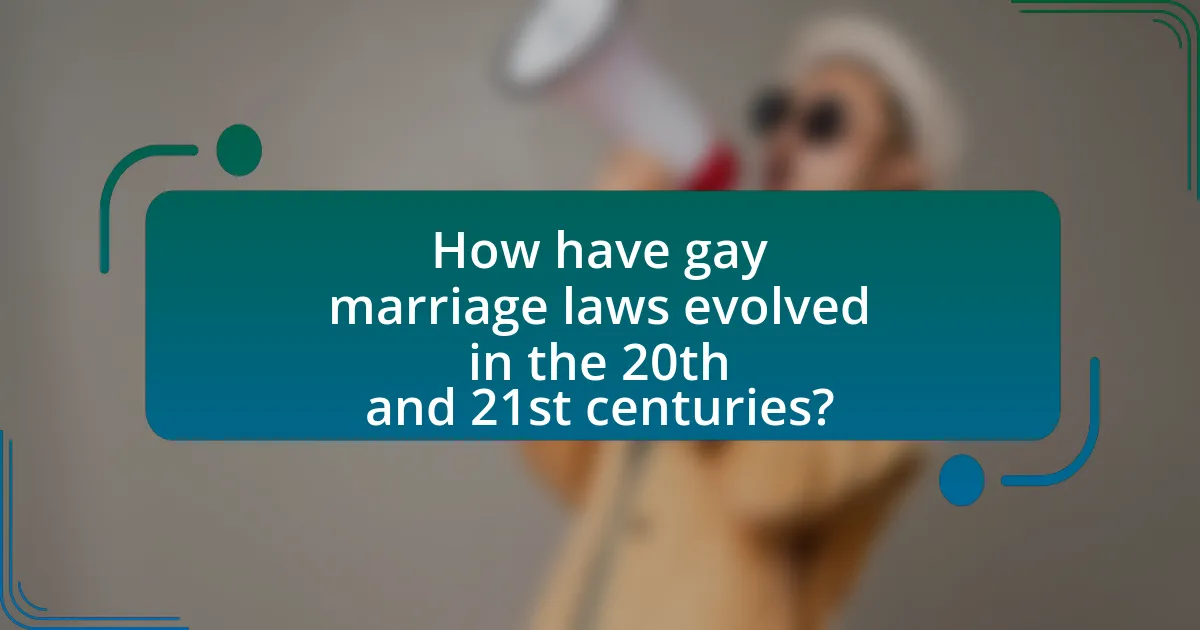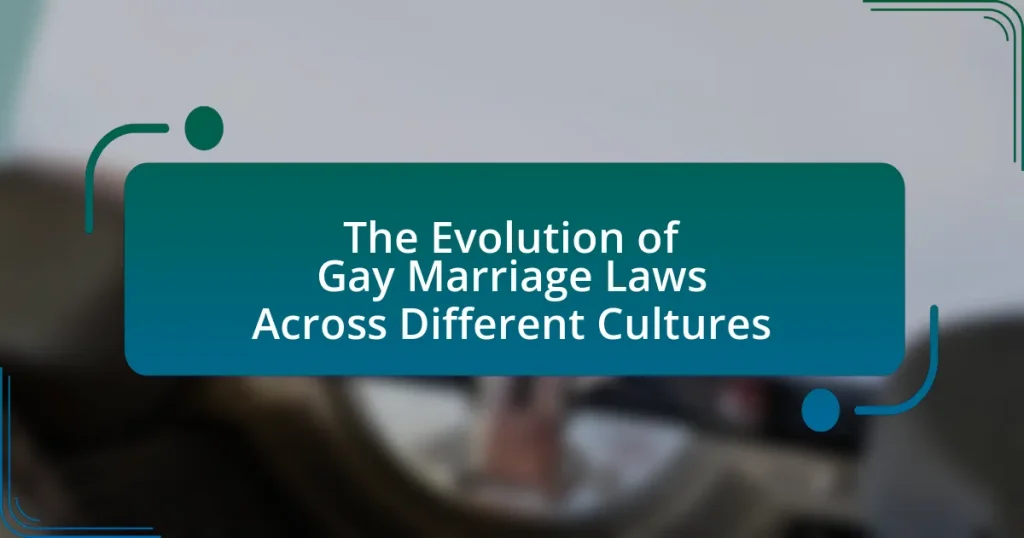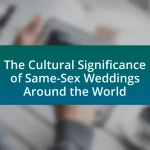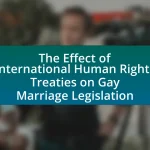The article examines the historical roots and evolution of gay marriage laws across various cultures, highlighting ancient societies that recognized same-sex unions, such as Greece, Rome, and Indigenous cultures in North America. It discusses the impact of religious beliefs and colonialism on the acceptance and legal recognition of same-sex relationships, as well as the significant milestones in the legalization of gay marriage from the late 20th century to the present. The article also explores the role of social movements, legal challenges, and cultural attitudes in shaping public opinion and the implications of gay marriage laws on LGBTQ+ rights and societal acceptance.

What are the historical roots of gay marriage laws across different cultures?
The historical roots of gay marriage laws across different cultures can be traced back to various ancient societies that recognized same-sex unions. For instance, in ancient Greece, relationships between men were often celebrated, and some city-states, like Sparta, had customs that acknowledged same-sex partnerships. Similarly, in ancient Rome, same-sex relationships were common, and while formal marriage was not recognized, certain legal protections existed for these unions.
In other cultures, such as among Indigenous peoples in North America, two-spirit individuals were often honored and could marry partners of the same sex, reflecting a broader acceptance of diverse sexual orientations. In contrast, many societies, particularly in the Abrahamic traditions, historically viewed same-sex relationships negatively, leading to the absence of legal recognition for gay marriages.
The modern movement for legal recognition of gay marriage began in the late 20th century, with the Netherlands becoming the first country to legalize same-sex marriage in 2001, setting a precedent that influenced other nations. This evolution reflects changing societal attitudes towards LGBTQ+ rights and the increasing recognition of marriage as a fundamental human right.
How have ancient civilizations approached the concept of same-sex unions?
Ancient civilizations approached the concept of same-sex unions with varying degrees of acceptance and institutional recognition. For instance, in ancient Greece, relationships between adult men and adolescent boys, known as pederasty, were socially acknowledged and often celebrated, although these relationships did not equate to marriage. Similarly, in ancient Rome, same-sex relationships were common, and while they were not formalized as marriage, they were accepted within certain social contexts, particularly among the elite. In contrast, ancient cultures such as the Aztecs recognized same-sex unions, with specific rituals and roles assigned to same-sex couples, indicating a level of societal acceptance. These historical examples illustrate that while the formal institution of marriage for same-sex couples was not universally established, many ancient civilizations had frameworks that acknowledged and accepted same-sex relationships in various forms.
What evidence exists of same-sex marriages in ancient cultures?
Evidence of same-sex marriages in ancient cultures includes documented practices in various civilizations, such as Ancient Rome, Ancient Greece, and among Indigenous cultures. In Ancient Rome, legal recognition of same-sex unions is indicated by the existence of the term “conubium,” which referred to a form of marriage that could include same-sex couples. Additionally, inscriptions and literary references, such as those found in the writings of the Roman poet Juvenal, suggest that same-sex relationships were socially acknowledged.
In Ancient Greece, relationships between men, particularly between an older man and a younger male, were often celebrated and could involve formalized partnerships akin to marriage, as seen in the concept of “philia.” The existence of rituals and ceremonies, such as those described by Plato in “Symposium,” further supports the notion of recognized same-sex unions.
Indigenous cultures, such as the Two-Spirit people among Native American tribes, also provide evidence of same-sex marriages, where individuals embodying both male and female traits were often celebrated and could enter into partnerships that resembled marriage. Historical accounts and anthropological studies document these practices, affirming their significance within those societies.
These examples collectively illustrate that same-sex marriages were recognized and practiced in various ancient cultures, supported by historical texts, legal terminology, and anthropological research.
How did religious beliefs influence same-sex unions in early societies?
Religious beliefs significantly influenced same-sex unions in early societies by either legitimizing or condemning such relationships. In ancient cultures, like those of the Greeks and Romans, certain religious practices accepted same-sex unions, often viewing them as expressions of love and companionship, which were sometimes celebrated in rituals. For instance, the worship of deities such as Aphrodite and Eros included elements that acknowledged same-sex love. Conversely, in other societies, particularly those influenced by Abrahamic religions, same-sex unions were often condemned, leading to legal and social repercussions for individuals involved in such relationships. This dichotomy illustrates how religious frameworks shaped societal norms regarding same-sex unions, either fostering acceptance or enforcing prohibition based on theological interpretations.
What role did colonialism play in shaping modern gay marriage laws?
Colonialism significantly influenced modern gay marriage laws by imposing Western legal frameworks that often criminalized same-sex relationships in colonized regions. During the colonial era, many European powers enacted laws that reflected their own cultural and moral values, which included the prohibition of homosexual acts. For instance, the British colonial laws, such as the Labouchere Amendment of 1885, criminalized male homosexual acts in many territories, leading to the stigmatization and marginalization of LGBTQ+ individuals. This legacy of criminalization persisted even after decolonization, affecting contemporary legal systems and societal attitudes towards homosexuality. Consequently, many post-colonial nations grapple with the remnants of these colonial laws, which continue to shape debates around gay marriage and LGBTQ+ rights today.
How did European colonial powers impact local marriage customs regarding same-sex relationships?
European colonial powers significantly altered local marriage customs regarding same-sex relationships by imposing their own legal frameworks and moral standards. For instance, many colonial administrations criminalized same-sex relationships, leading to the suppression of indigenous practices that recognized or accepted such unions. In regions like Africa and the Caribbean, colonial laws often replaced traditional customs, which had previously allowed for same-sex partnerships, with European legal codes that deemed these relationships illegal. Historical records indicate that in British colonies, laws such as the Labouchere Amendment of 1885 criminalized homosexual acts, thereby erasing existing cultural acceptance and practices. This legal imposition not only marginalized same-sex relationships but also contributed to a broader cultural stigma that persists in many post-colonial societies today.
What were the consequences of colonial laws on indigenous practices?
Colonial laws significantly disrupted indigenous practices by imposing foreign legal frameworks that often criminalized traditional customs and social structures. For instance, in many regions, colonial authorities enacted laws that prohibited indigenous marriage practices, leading to the erosion of cultural identity and community cohesion. This legal imposition resulted in the marginalization of indigenous voices and the loss of traditional knowledge, as seen in the suppression of ceremonies and rituals that were integral to indigenous societies. Historical evidence shows that these laws not only altered social dynamics but also contributed to long-term socio-economic disadvantages for indigenous populations, as they were often excluded from legal recognition and rights associated with land and family.

How have gay marriage laws evolved in the 20th and 21st centuries?
Gay marriage laws have evolved significantly in the 20th and 21st centuries, transitioning from criminalization and social stigma to legal recognition and acceptance in many countries. In the late 20th century, the first legal recognition of same-sex relationships occurred in Denmark in 1989 with the introduction of registered partnerships, which provided some legal rights without full marriage equality. The movement gained momentum in the early 21st century, with the Netherlands becoming the first country to legalize same-sex marriage in 2001.
Following this, numerous countries, including Canada in 2005 and the United States in 2015 through the Supreme Court ruling in Obergefell v. Hodges, recognized same-sex marriage, reflecting a broader societal shift towards acceptance. By 2023, over 30 countries had legalized same-sex marriage, demonstrating a significant change in legal frameworks and cultural attitudes towards LGBTQ+ rights globally.
What significant milestones have marked the legalization of gay marriage globally?
The significant milestones that have marked the legalization of gay marriage globally include the Netherlands becoming the first country to legalize same-sex marriage in 2001, followed by Belgium in 2003, and Canada in 2005. In the United States, the Supreme Court’s ruling in Obergefell v. Hodges in 2015 legalized same-sex marriage nationwide, marking a pivotal moment in LGBTQ+ rights. Other notable milestones include the legalization of gay marriage in countries like Spain in 2005, South Africa in 2006, and Germany in 2017. These events reflect a growing acceptance and legal recognition of same-sex relationships across various cultures and nations.
Which countries were the first to legalize gay marriage, and what were the driving factors?
The first countries to legalize gay marriage were the Netherlands in 2001, followed by Belgium in 2003, Canada in 2005, and Spain in 2005. The driving factors for these legalizations included a combination of social movements advocating for LGBTQ+ rights, changing public attitudes towards homosexuality, and legal frameworks that supported equality and non-discrimination. In the Netherlands, for instance, a strong civil rights movement and public support led to the legalization, reflecting a broader trend of increasing acceptance of same-sex relationships in Dutch society.
How have social movements influenced the progression of gay marriage laws?
Social movements have significantly influenced the progression of gay marriage laws by advocating for LGBTQ+ rights and raising public awareness. For instance, the Stonewall Riots in 1969 marked a pivotal moment, galvanizing activism that led to increased visibility and support for LGBTQ+ issues. This activism contributed to legal changes, such as the Massachusetts Supreme Judicial Court ruling in 2003 that legalized same-sex marriage, which set a precedent for other states. Additionally, organizations like the Human Rights Campaign have mobilized resources and campaigns that have educated the public and lobbied lawmakers, resulting in the legalization of same-sex marriage in numerous countries, including the landmark U.S. Supreme Court decision in Obergefell v. Hodges in 2015, which affirmed the constitutional right to marry for same-sex couples.
What legal challenges have arisen in the fight for gay marriage rights?
Legal challenges in the fight for gay marriage rights have included constitutional disputes, state-level bans, and federal recognition issues. For instance, the Defense of Marriage Act (DOMA), enacted in 1996, defined marriage as a union between one man and one woman, leading to numerous legal battles over its constitutionality. In 2013, the Supreme Court ruled in United States v. Windsor that DOMA was unconstitutional, which set a precedent for further challenges. Additionally, various states enacted laws prohibiting same-sex marriage, prompting lawsuits that argued these bans violated equal protection and due process rights under the Fourteenth Amendment. The culmination of these legal challenges was the landmark Supreme Court decision in Obergefell v. Hodges in 2015, which legalized same-sex marriage nationwide, affirming that the right to marry is a fundamental liberty.
What are some landmark court cases that have shaped gay marriage laws?
Landmark court cases that have shaped gay marriage laws include Obergefell v. Hodges (2015), which legalized same-sex marriage nationwide in the United States, ruling that state bans on same-sex marriage violated the Fourteenth Amendment. Another significant case is United States v. Windsor (2013), where the Supreme Court struck down the Defense of Marriage Act, affirming that the federal government must recognize same-sex marriages performed in states where they are legal. Additionally, Goodridge v. Department of Public Health (2003) was the first state supreme court case to rule in favor of same-sex marriage, setting a precedent for other states to follow. These cases collectively advanced the legal recognition of same-sex marriage and influenced laws across various jurisdictions.
How do legal definitions of marriage vary across different jurisdictions?
Legal definitions of marriage vary significantly across different jurisdictions, reflecting diverse cultural, religious, and legal perspectives. For instance, in the United States, marriage is defined at the state level, leading to variations such as the recognition of same-sex marriage in some states while others may not recognize it at all. In contrast, countries like Canada and the Netherlands have legalized same-sex marriage nationwide, establishing a uniform legal definition. Additionally, some jurisdictions may define marriage strictly as a union between a man and a woman, while others may include same-sex couples, demonstrating the influence of local laws and societal norms on the legal understanding of marriage.

What cultural attitudes influence the acceptance of gay marriage laws?
Cultural attitudes that influence the acceptance of gay marriage laws include religious beliefs, societal norms, and historical context. Religious beliefs often dictate views on marriage, with many faiths traditionally opposing same-sex unions, which can hinder acceptance. Societal norms, shaped by cultural values and peer influences, also play a significant role; communities that prioritize individual rights and equality tend to support gay marriage more than those with conservative views. Historical context, such as past discrimination or progressive movements, can further affect acceptance levels, as seen in countries like the Netherlands, which legalized gay marriage in 2001, reflecting a long-standing commitment to human rights.
How do cultural beliefs and values shape public opinion on gay marriage?
Cultural beliefs and values significantly shape public opinion on gay marriage by influencing perceptions of morality, family structure, and social norms. For instance, societies with strong religious beliefs often view gay marriage as contrary to traditional values, leading to opposition among their populations. In contrast, cultures that prioritize individual rights and equality tend to support gay marriage, reflecting a shift in public opinion towards acceptance. Research from the Pew Research Center indicates that in countries where LGBTQ+ rights are recognized and celebrated, such as in many Western nations, public support for gay marriage has increased dramatically, with approval rates reaching over 70% in some areas. This demonstrates that cultural context directly impacts how communities perceive and accept gay marriage, shaping legislative outcomes and societal attitudes.
What role do religion and tradition play in shaping attitudes towards gay marriage?
Religion and tradition significantly influence attitudes towards gay marriage by establishing moral frameworks and societal norms. Many religious doctrines, such as those in Christianity, Islam, and Judaism, traditionally view marriage as a union between a man and a woman, leading to opposition against gay marriage among adherents. For instance, a 2019 Pew Research Center survey found that in countries with strong religious affiliations, such as Nigeria and Egypt, a majority oppose same-sex marriage, reflecting the impact of religious beliefs on societal attitudes. Additionally, cultural traditions often reinforce these religious views, perpetuating resistance to change. In contrast, societies that prioritize secularism or have more progressive religious interpretations tend to show greater acceptance of gay marriage, as seen in countries like Canada and the Netherlands, where legal recognition of same-sex unions has been established.
How does media representation affect societal views on gay marriage?
Media representation significantly influences societal views on gay marriage by shaping public perceptions and attitudes. Positive portrayals of same-sex relationships in television, film, and news media have been linked to increased acceptance and support for gay marriage. For instance, a study published in the journal “Communication Research” found that exposure to LGBTQ+ characters in popular media correlates with more favorable attitudes toward gay marriage among viewers. This effect is particularly pronounced among younger audiences, who are more likely to consume media that includes diverse representations. Additionally, media narratives that humanize LGBTQ+ individuals and highlight their struggles for equality contribute to a broader understanding and acceptance of gay marriage within society.
What are the implications of gay marriage laws on LGBTQ+ rights and society?
Gay marriage laws significantly enhance LGBTQ+ rights and foster societal acceptance. Legal recognition of same-sex marriages provides LGBTQ+ individuals with equal rights in areas such as inheritance, taxation, and healthcare, which were previously inaccessible. For instance, after the legalization of same-sex marriage in the United States in 2015, studies indicated a marked decrease in mental health issues among LGBTQ+ individuals, highlighting the positive societal impact of legal recognition. Furthermore, countries that have enacted gay marriage laws often experience increased visibility and acceptance of LGBTQ+ communities, contributing to broader social change and reducing discrimination. This correlation is supported by research from the Williams Institute, which found that legalizing same-sex marriage correlates with a decline in anti-LGBTQ+ hate crimes.
How does the legalization of gay marriage impact LGBTQ+ communities?
The legalization of gay marriage positively impacts LGBTQ+ communities by providing legal recognition and protection for same-sex couples, which enhances their social acceptance and equality. This legal recognition allows LGBTQ+ individuals to access the same rights and benefits as heterosexual couples, including tax benefits, inheritance rights, and healthcare decisions. Studies, such as those conducted by the Williams Institute, show that states with legalized gay marriage experience a decrease in mental health issues among LGBTQ+ individuals, indicating improved well-being and societal acceptance. Furthermore, the legalization fosters a sense of belonging and validation within the community, contributing to greater visibility and advocacy for LGBTQ+ rights.
What are the potential social and economic benefits of legalizing gay marriage?
Legalizing gay marriage offers significant social and economic benefits. Socially, it promotes equality and acceptance, fostering a more inclusive society where LGBTQ+ individuals can enjoy the same rights and recognition as heterosexual couples. This inclusion can lead to improved mental health outcomes for LGBTQ+ individuals, as studies indicate that legal recognition reduces stigma and discrimination, contributing to overall societal well-being.
Economically, legalizing gay marriage can boost local economies through increased spending on weddings and related services. A study by the Williams Institute estimated that legalizing same-sex marriage in the United States could generate approximately $2.5 billion in economic activity, driven by expenditures on venues, catering, and other wedding-related services. Additionally, legal recognition of same-sex marriages can enhance job security and benefits for LGBTQ+ employees, leading to increased productivity and economic contributions.
Overall, the legalization of gay marriage not only affirms the rights of individuals but also contributes positively to societal cohesion and economic growth.
What best practices can be adopted to support the evolution of gay marriage laws?
To support the evolution of gay marriage laws, advocacy for comprehensive legal reforms is essential. This includes lobbying for legislative changes that recognize same-sex marriage, as seen in countries like Canada, where the Civil Marriage Act of 2005 legalized same-sex marriage nationwide. Additionally, public education campaigns can raise awareness and promote acceptance, similar to the successful campaigns in the United States leading up to the Supreme Court’s decision in Obergefell v. Hodges in 2015, which legalized same-sex marriage across the country. Engaging with diverse communities to foster dialogue and understanding can also facilitate cultural shifts, as demonstrated by the increasing acceptance of LGBTQ+ rights in various societies globally.


